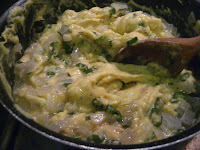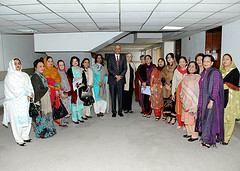 In preparation for this month's cooking task, I visited London's only Bajan restaurant, Bajan Spice which is on Nunhead Common in Southwark. I have to say that, for such a modest, unassuming cafe, the food at Bajan Spice is pretty amazing! I'd highly recommend it, if you're based in London, or just visiting and want to sample some Bajan cuisine.
In preparation for this month's cooking task, I visited London's only Bajan restaurant, Bajan Spice which is on Nunhead Common in Southwark. I have to say that, for such a modest, unassuming cafe, the food at Bajan Spice is pretty amazing! I'd highly recommend it, if you're based in London, or just visiting and want to sample some Bajan cuisine. The National Dishes of Barbados
 |
| Bajan Spice at Nunhead Common |
 |
| Pudding & Souse |
Flying Fish and Cou Cou
 |
| Fried Fish and Cou Cou |
Lots of recipes had 'modernised' the dish, with lots of rich sauces and tomatoey flavours, but I was aware of the comments section on other blogs, where enraged Bajans extolled the virtues of a much simpler dish. Also, there wasn't one recipe for this, but separate recipes for each part of the dish. I'm afraid I might have missed the sauce part and I would definitely recommend some kind of sauce for this dish, if you decide to make it yourself.
How to fillet a fish
Also - another good learning experience for me was how to fillet fish, as I'd never done this before! (Any readers who've stumbled on this blog and are taking it for a professional cooking blog, please look away now!). It was quite straight forward, although messy and I didn't have a proper 'fish tweezers thingy' to remove the rib-cage bones. I found it really useful to watch the following video on Youtube by the Underground Cookery school, which explains how to fillet round fish, like snappers:
I'm not a big 'fish-eater' but cooking for this blog has made me aware of how important fish is to different cultures across the world.
The Ingredients
 |
| The Ingredients |
1 onion (chopped)
8-10 okra (sliced)
a bowlful of cornmeal (and extra to thicken the Cou Cou)
butter (to grease the Cou Cou container)
For the Fried Fish
2 snappers or other round fish (filleted!)
Lemon juice
Dried thyme
Garlic salt
Cayenne pepper
Sea salt
Black pepper
Flour (or, even better, cornflour)
1 egg
Breadcrumbs
How I made Cou Cou
 |
| Mmmm . . . lovely okra! |
the pieces of okra and let these fry for a minute, before adding a litre of water. The last time I cooked okra was when I was blogging about Oklahoma. Actually, reading through my Oklahoman recipe for Choctaw Catfish and Fried Okra, it's got a lot in common with Cou Cou and Fried Fish!
It's important not to over-boil okra so, after a few minutes, I removed the okra and fried onion, using a slotted spoon and put them in a bowl to be added again later. At this point, I poured half of the liquid into a container and started stirring the cornmeal (polenta) into the remaining liquid.
 |
| Fry the onion with some dried thyme |
 |
| Add the okra and about 1 litre of water |
 |
| Mixing cornmeal, onion and okra |
 |
| It should look something like this! |
Once the cornmeal and liquid had thickened somewhat, I put the fried onion and okra back into the mixture. After a few more minutes, I poured everything into an oven-proof container and baked it for about 10 minutes to solidify the Cou Cou. I was quite pleased with the end result, although my photo doesn't really do it justice!
What to do with the fillet of fish
Once I had filleted the fish, I washed it in lemon juice and then rinsed it with water. I then put the fillets into a bowl and covered them with a mixture of dried thyme, garlic salt, cayenne pepper, sea salt and black pepper. I covered the bowl and let it marinate in the fridge for about an hour and a half (during which time I had a snooze - no one said cooking Bajan food had to be stressful!).
 |
| Wash the fish fillets with lemon juice |
 |
| The spices, herbs and salts for marinating |
Once marinated, I coated the fish fillets in cornflour (you could also use regular flour), dipped them in the egg, which I had beaten in a bowl and pressed them onto a plate full of breadcrumbs. I had also prepared the bread crumbs in my food processor and I think fresh bread crumbs make all the difference.
 |
| Hunks of bread |
 |
| and bread crumbs! |
Marinated, coated, dipped and pressed, I finally fried the fillets and served them up with the slabs of Cou Cou. The Cou Cou was nice, the fish was delicious and I'll definitely be using elements of this recipe again - in fact, I'm planning a Cou Cou & Fried Chicken dish for later this week.
 |
| Frying the fish fillets |
 |
| Fried fish and Cou Cou |
Image credits:
All photos were taken by me - please feel free to re-use these images under the Creative commons license:
- Share alike
- Attribute (especially to this blog post)
- Non-commercial
Some of the websites I used for the recipe were:
www.tasteslikehome.org
www.islandflave.com
www.totallybarbados.com





.JPG)






